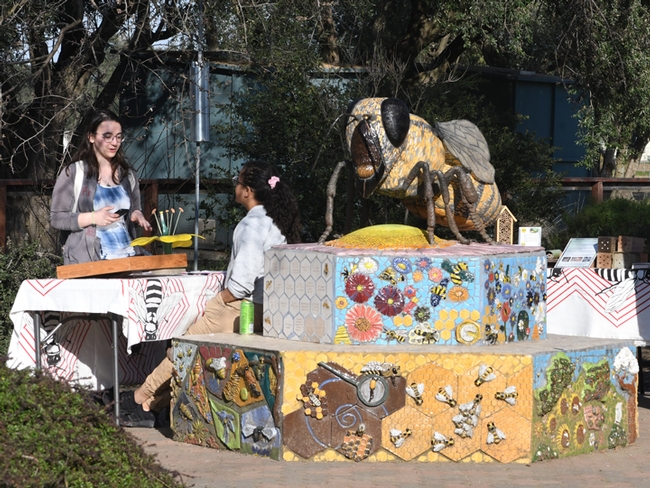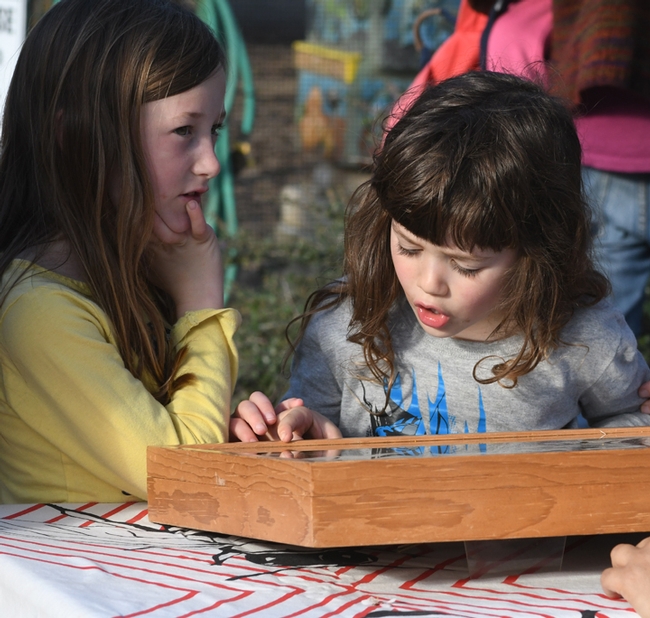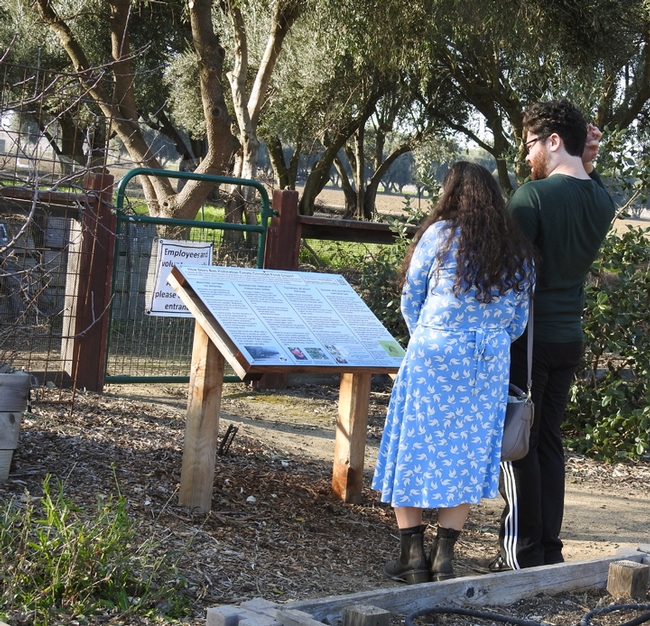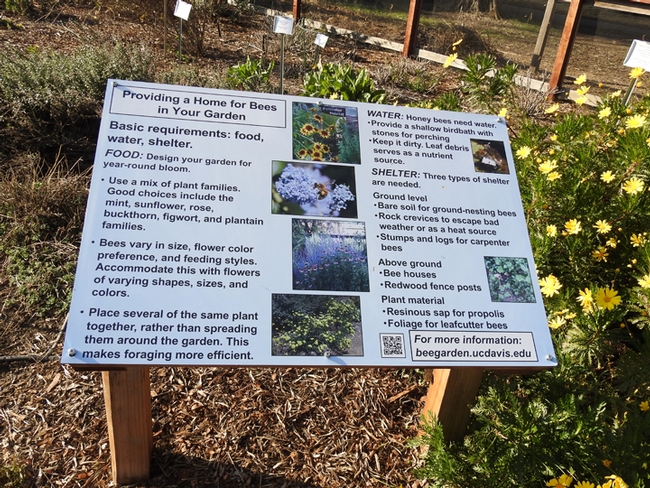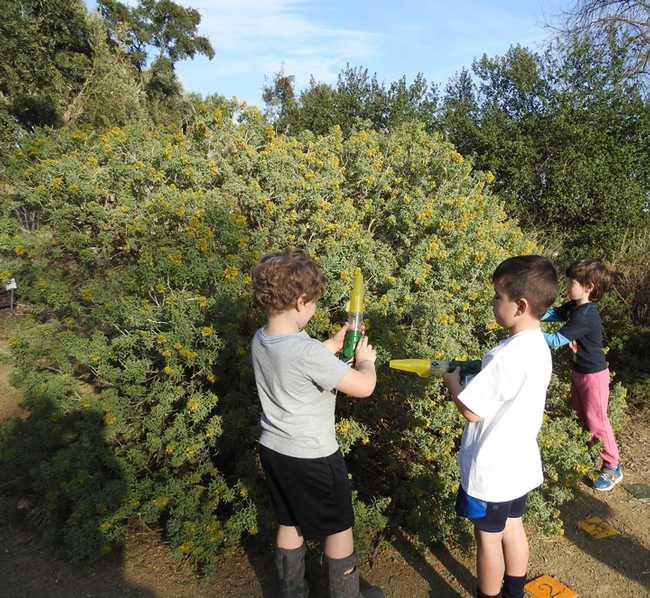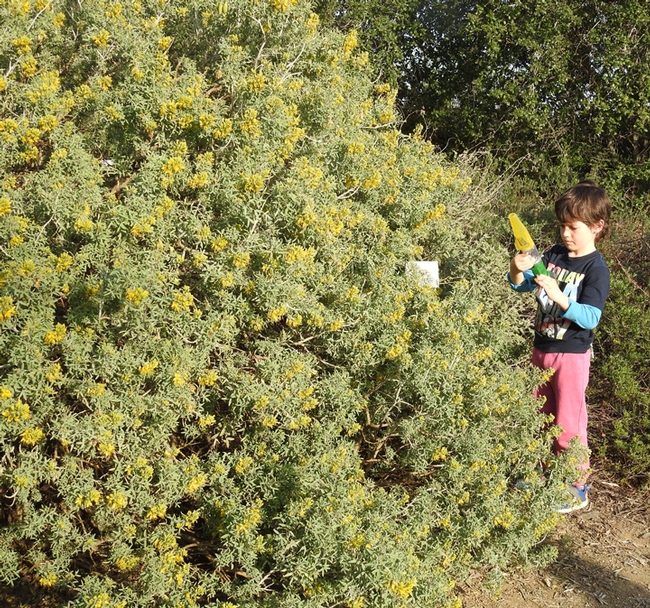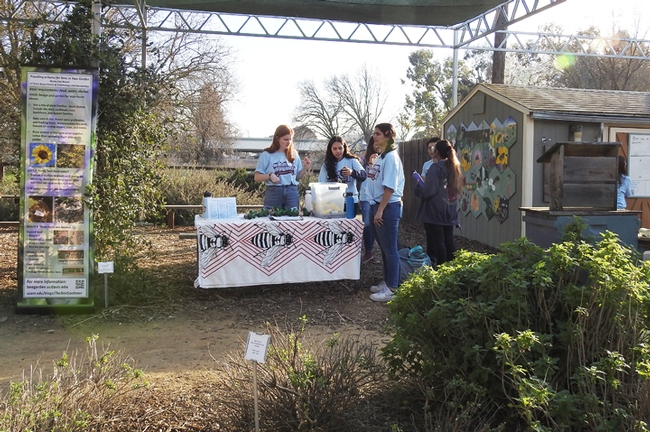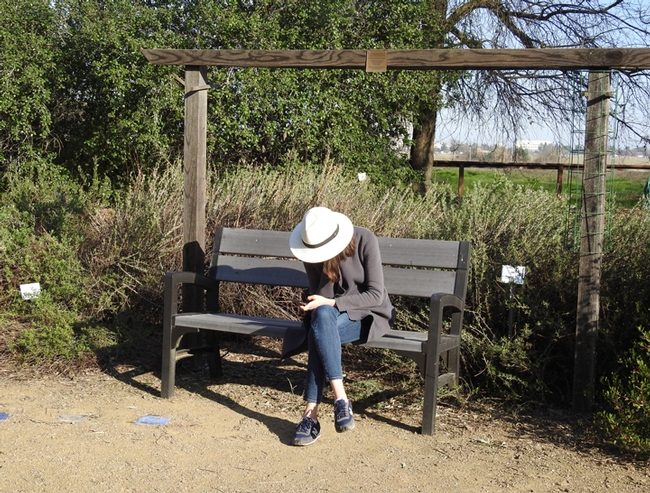- Author: Kathy Keatley Garvey
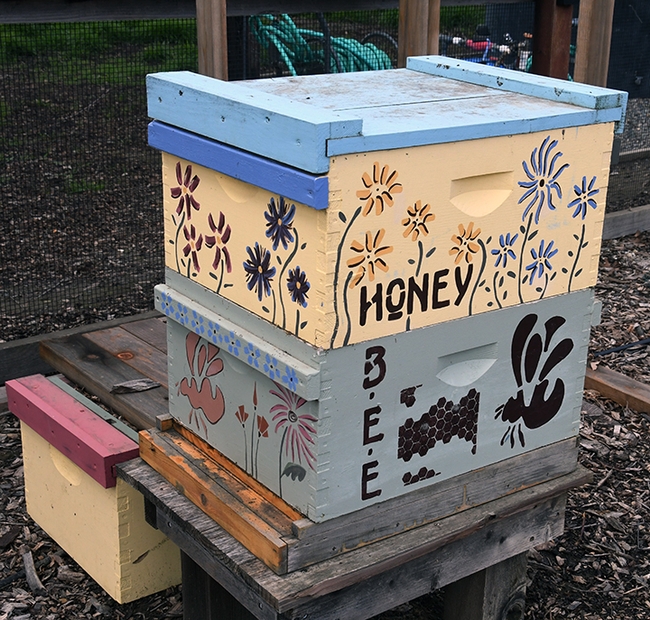
No, wait. Catch...examine...and then release.
That's what attendees will do at the UC Davis Bee Haven's 15th anniversary celebration, set from 10 a.m. to noon on Saturday, April 6 on Bee Biology Road, west of the central campus.
They'll be using a bee vacuum device to scoop up a honey bee, carpenter bee, bumble bee or other pollinator for close observation.
The half-acre garden is located next to the Harry H. Laidlaw Jr. Honey Research Facility. Both are part of the UC Davis Department of Entomology and Nematology.
The open house, free and family friendly, will include a tour of the garden at 11 a.m.; catch-and-release bee activity to observe bees up close; information about low-water plants; and presentations on University of California pollinator research.
The haven is open daily from dawn to dusk (no admission). It is described as "a unique outdoor museum that provides resources for local bee pollinators, inspires and educates visitors to create pollinator habitat gardens, and provides a site for the observation and study of bees and the plants that support them."
Director of the garden is Elina Lastro Niño, associate professor of Cooperative Extension - Apiculture, UC Davis Department of Entomology and Nematology. Christine Casey is the manager, the academic program management officer.
Workers installed the garden in the fall of 2009, under the tenure of interim department chair Lynn Kimsey, now UC Davis distinguished professor emerita, and with primary funds from the Häagen-Dazs ice cream brand. Featuring a series of interconnected gardens with names like “Honeycomb Hideout,” “Nectar Nook” and “Pollinator Patch,” it was designed to provide the Laidlaw honey bees with a year-around food source, raise public awareness about the plight of honey bees, encourage visitors to plant bee-friendly gardens of their own, and serve as a research site.
A six-foot worker bee sculpture of ceramic and mosaic anchors the garden. It's the work of self-described "rock artist" Donna Billick of Davis. UC Davis distinguished professor Diane Ullman and Billick co-founded and directed the UC Davis Art-Science Fusion Program, and their art and that of Ullman's entomology students, as well as members of the community and other volunteers, are showcased throughout the garden.
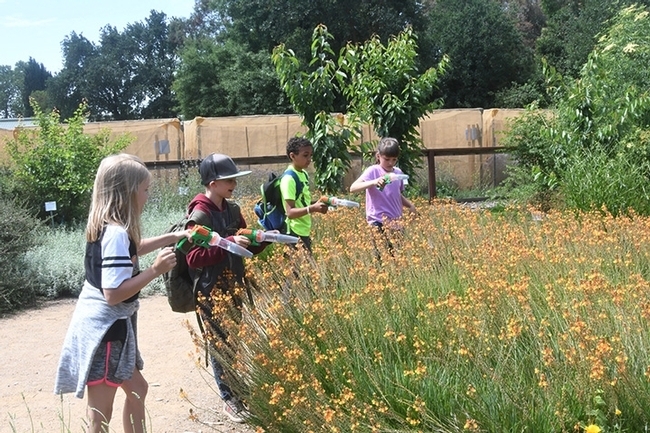
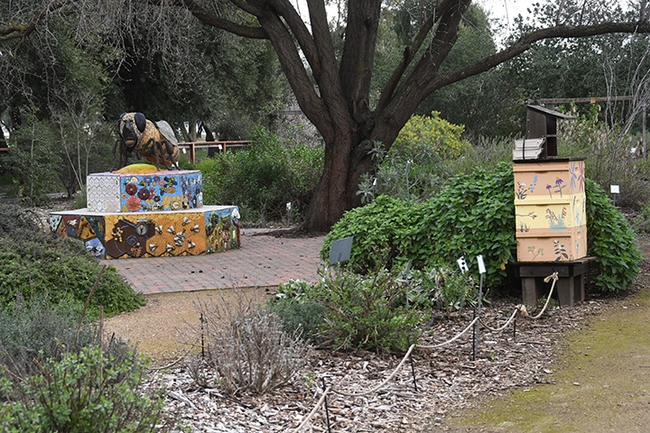
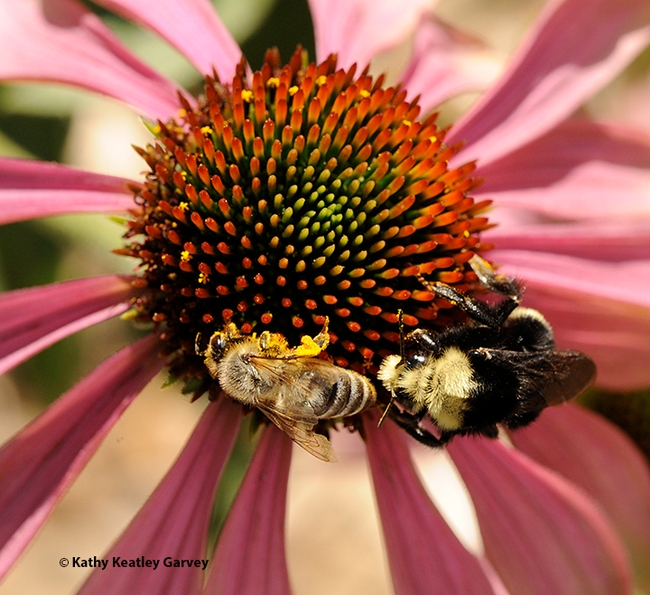
- Author: Kathy Keatley Garvey
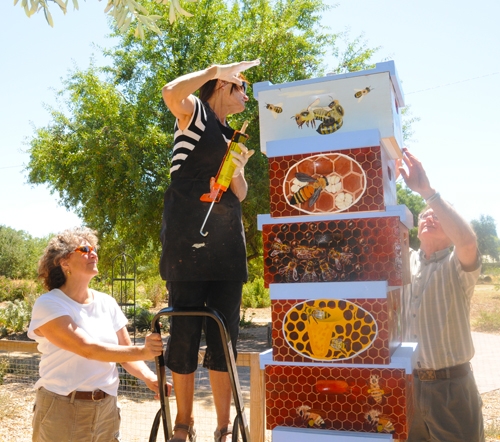
But the event also will include several tours to museums or collections.
One of the tours will be to the UC Davis Bee Haven, a half-acre bee demonstration garden located next to the Harry H. Laidlaw Jr. Honey Bee Research Facility on Bee Biology Road, west of the central campus.
Honey bees and native bees, as well as butterflies, dragonflies and other insects, frequent the garden.
The Haven staff will offer tours at noon and at 2 p.m., with a limit of 20 people per tour. "We'll focus on how best to observe and identify bees in the garden, as well as suggested bee plants that grow well in our area with low water," said Christine Casey, academic program management officer of the Bee Haven.
The garden, operated and maintained by the UC Davis Department of Entomology and Nematology, was installed in the fall of 2009 when professor Lynn Kimsey, director of the Bohart Museum of Entomology headed the department as interim chair. The art featured in the garden is the work of the UC Davis Art/Science Fusion Program, co-founded and co-directed by entomology professor/artist Diane Ullman and self-described "rock artist" Donna Billick. A six-foot-long ceramic-mosaic bee sculpture, crafted by Billick, anchors the garden. Columns of ceramic-mosaic bee boxes flank the entrance. Other sculptures beautify the garden as well.

Another project, supervised by Ullman and Billick in 2011 and coordinated by then doctoral student Sarah Dalrymple of the Rick Karban lab, features a mural of mostly native bees on the garden shed.
Background: Ullman and Billick were teaching an Entomology 1 class, "Art, Science and the World of Insects," with 22 students enrolled. Dalrymple, the teaching assistant, guided the students in the design, creation and installation of the panels.
The 22 students portrayed 22 bees, including such natives as mason, sweat, squash, leafcutter, blue orchard, carpenter and bumble bees. One of the non-natives: the European wool carder bee.
The UC Davis Bee Haven is in the midst of raising funds to finance classroom visits from low-income schools, and visits by youth groups. The fundraising project, with a goal of $3000, ends at 12:59 p.m., Feb 28. View Casey's ;YouTube video and access the Haven website. The CrowdFund site is at https://crowdfund.ucdavis.edu/project/29773
The bee garden is open daily from dawn to dusk except for Tuesdays (opens at 10 a.m.) "so we can maintain physical distance during garden maintenance," Casey says. Admission is free.
Resource:
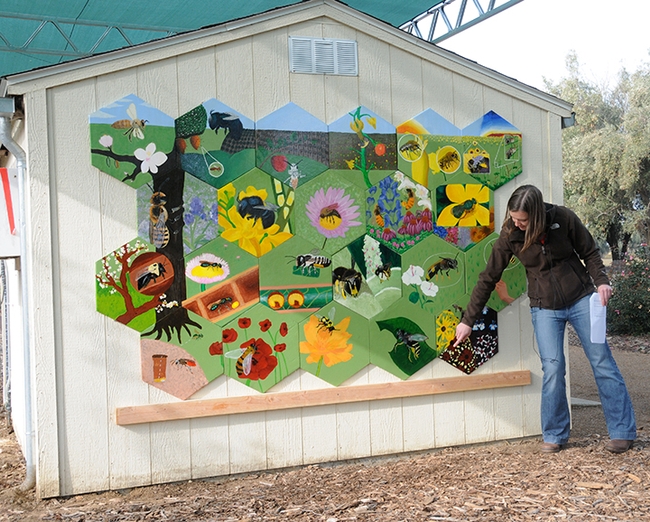
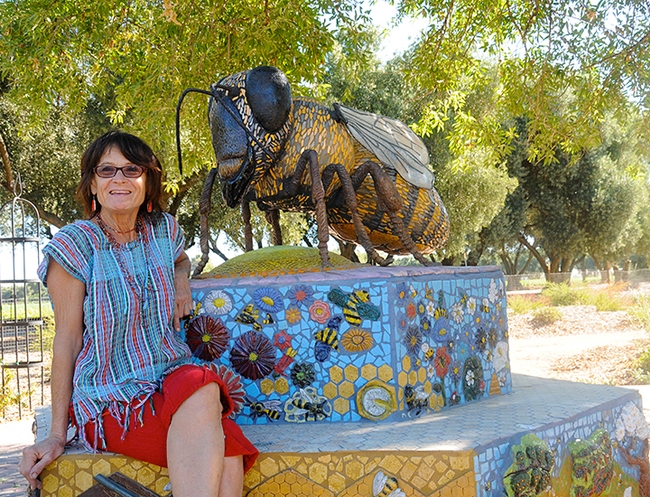
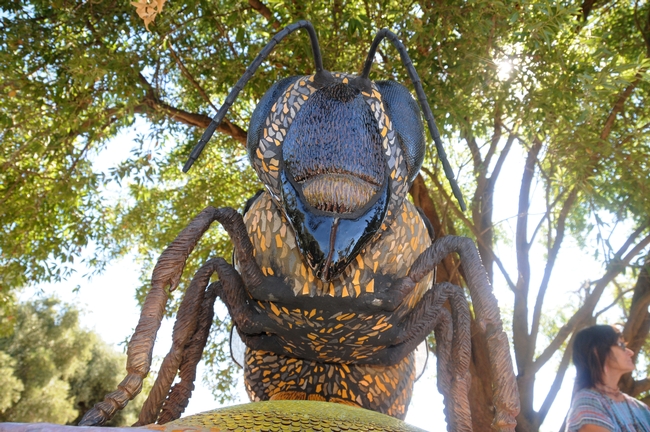

- Author: Kathy Keatley Garvey
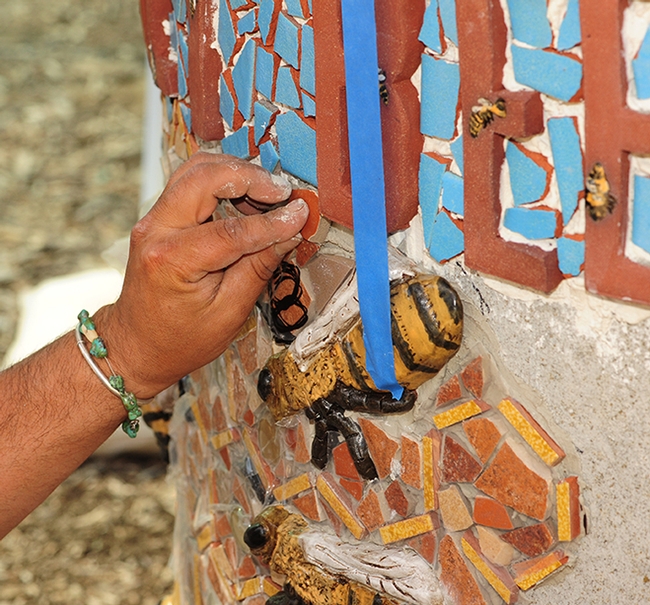
We remember when professional ceramic- mosaic artist Mark Rivera of Davis joined fellow artists in May of 2013 to install newly created art projects at the UC Davis Department of Entomology and Nematology's bee garden, the Häagen-Dazs Honey Bee Haven on Bee Biology Road.
The talented artist was there to assist the UC Davis Art/Science Fusion Program, launched and directed by entomologist/artist Diane Ullman, UC Davis professor of entomology and former chair of the department, and artist-educator Donna Billick of Davis, a self-described "rock artist."
We remember Mark's paint-daubed hands, his gracious humility, and his gentle soul as he worked with Ullman and Billick to install the ceramic mosaic art on the planters at the haven. He and all of us around him were admiring the honey bees: bee motifs on the planters; bees foraging on the flowers in the half-acre garden; and bees hived at the nearby Harry H. Laidlaw Jr. Honey Bee Research Facility.
Mark Rivera died in sleep on May 22 at age 49. He would have been 50 on June 10.
His daughter, Jessica Williams, remembers him as "a kind, compassionate, and genuine soul who touched the lives of many. He was also a talented mosaic artist and created countless pieces of art throughout his community of Davis, California."
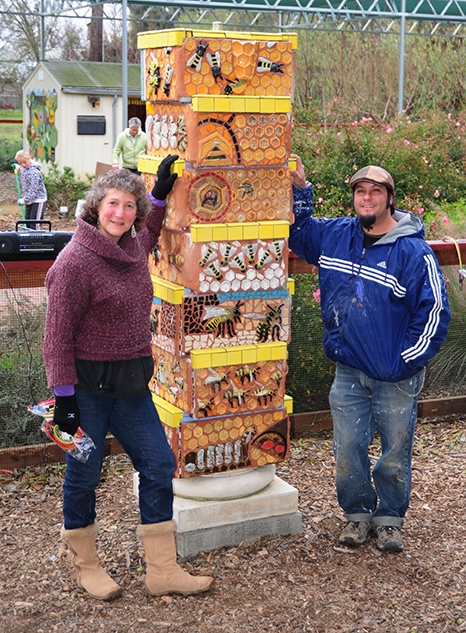
"Art and emotion intertwined for Mark. He channeled himself through different mediums, ultimately settling on ceramics, terrazzo and mosaics; these became his 'Mosaic Marks.'
"He was drawn to working on public works of art that were large and impactful. He started with public art in Denver and decided to make the big move in 2000 to Davis for additional opportunities to grow as an artist. He continued with pieces around Davis that reflected the evolution of his soul — having a daughter (Jessica), becoming an uncle (to Josie and Allie) and losing his father."
"His soul and his spirit shined from him and was witnessed by all who met him, leaving an everlasting impact."
"A Celebration of Life is planned for Thursday, June 10, in Central Park in Davis--preceded by an Art Procession from the Co-Op at 4:30 p.m. The Celebration of Mark's Life will start in the Central Park gardens at 6 p.m. for a sharing of stories by those who experienced various aspects of his life."
Ullman recently wrote on her Facebook page: "Mark was a talented man, very kind and compassionate. He was a wonderful teacher and partner in community-built projects. In the UC Davis Art/Science Fusion Program, Mark assisted with nearly every installation we did on campus and even helped us install Nature's Gallery in Washington DC. In this go fund me campaign, his family is raising money for his funeral costs and memorial. If you wish to help, the link is here. His art installations grace our daily lives in Davis. He will be terribly missed."

- "Mark has always filled me with joy. He transformed the world around him. He inspired me and so many others to be better. I miss him terribly."
- "He was an amazing, unique artist and I always remember him as a solid and cheerful person."
- "Mark Rivera was a prolific ceramic & mosaic artist, you literally cannot go anywhere in Davis without seeing his colorful and vibrant installations. He was also an incredibly caring, gentle, and humble man, who seemed to always have a big smile on the ready & a twinkle in his eye."
Another friend posted author-poet Anita Krishan's quote that captures the artistic magic of the legacy of Mark Rivera:
“We are mosaics--pieces of light, love, history, stars--glued together with magic and music and words.”
Resources:
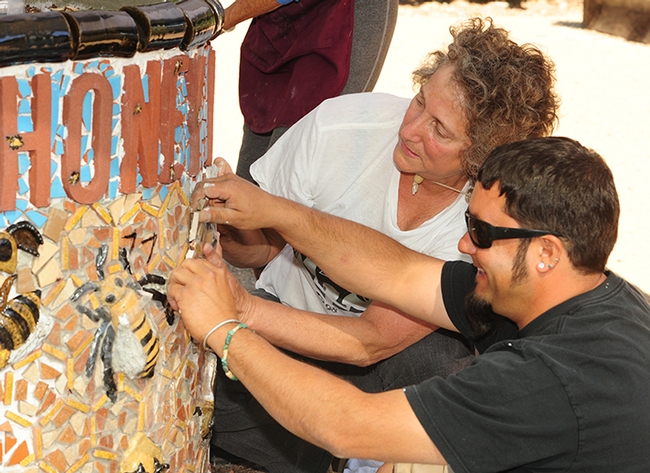
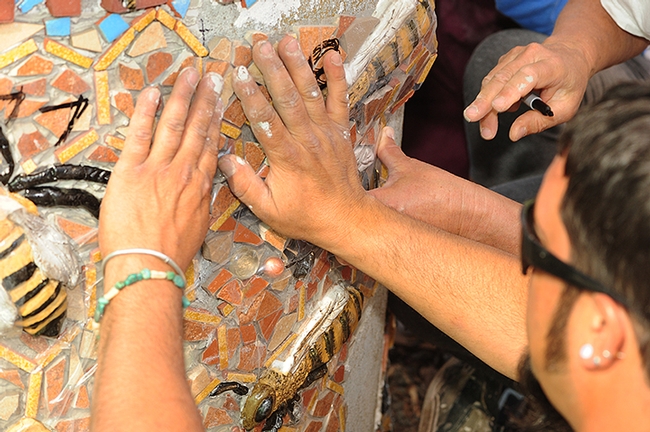
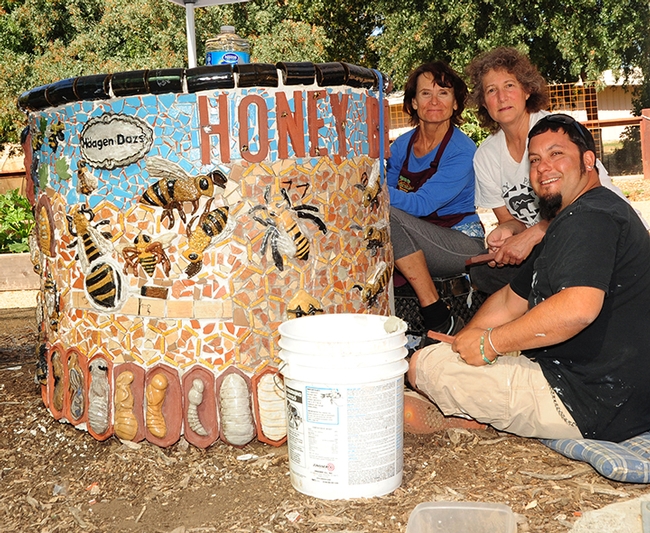
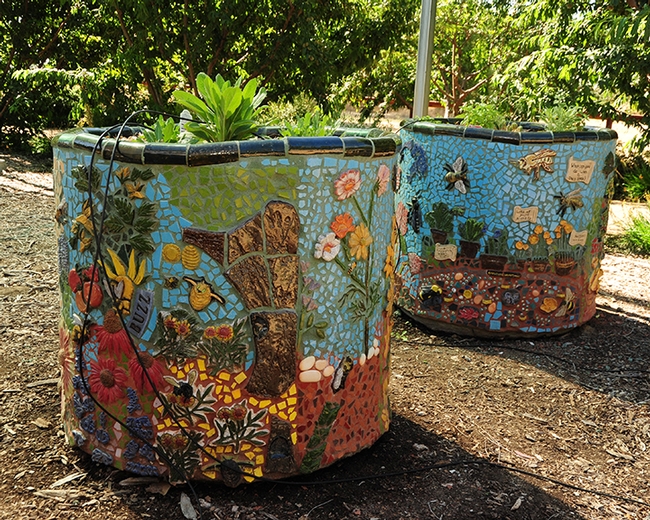
- Author: Kathy Keatley Garvey
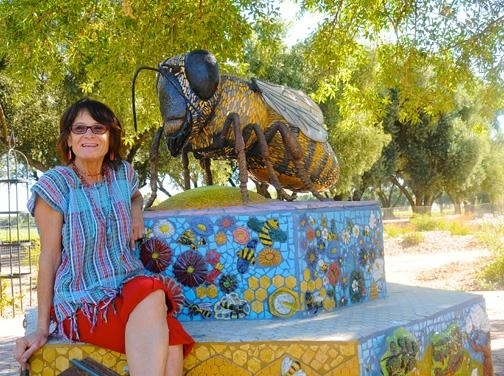
Titled "Miss Bee Haven," it anchors the half-acre bee garden, which was installed in the fall of 2009 and named for its primary donor.
The sculpture is the work of self-described "rock artist" Donna Billick of Davis. She designed, fabricated and constructed Miss Bee Haven, using rebar, chicken wire, sand, cement, tile, bronze, steel, grout, fiberglass and handmade ceramic pieces. The project took her four months to complete.
Miss Bee Haven, appropriately placed beneath an almond tree in June, 2010, is no lightweight. Anchored with 200 pounds of cement and with six bronze legs drilled into the pedestal, this worker bee is destined to stay put—unlike the thousands of bees that forage from the hives at the nearby Harry H. Laidlaw Jr. Honey Bee Research Facility.
Billick used lost wax bronze casting to craft the six legs, which extend from the thorax to rest on a ceramic “purple dome” aster, fabricated by Davis artist Sarah Rizzo. The purple dome aster is among the flowers in the garden.
She created the double set of translucent wings with three sheets of fiberglass. The result: wings that are fragile-looking and true to life, but strong.
During this entire process, I developed a real in-depth relationship with honey bees,” Billick told us back in 2010. For inspiration and detail, she visited the Laidlaw facility apiary, read about the functions of bees, and held the thoughts close. “It was not about expressing anything other than the beeness. I have a lot of respect for bees. It was fun and satisfying to do. I learned a ton.”
Billick toyed with a scientific career before opting for a career that fuses art with science. She received her bachelor of science degree in genetics in 1973 and her master's degree in fine arts in 1977, studying art with such masters as Bob Arneson, Roy De Forest, Wayne Thiebaud and Manuel Neri.
Billick traces her interest in an art career to the mid-1970s when then Gov. Jerry Brown supported the arts and offered the necessary resources to encourage the growth of art. He reorganized the California Arts Council, boosting its funding by 1300 percent.
The mid-1990s is when Billick and Ullman began teaching classes that fused art with science; those classes led to the formation of the UC Davis Art/Science Fusion.
The garden, maintained and operated by the UC Davis Department of Entomology and Nematology, is directed by Extension apiculturist Elina Lastro Niño and managed by Christine Casey. It is open to the public from dawn to dusk. Admission is free.
Meanwhile, "Miss Bee Haven" is likely the most photographed bee in the garden. Visitors pull out their cell phones to take a selfie. Children love to touch it and help the younger ones climb to the ledge. Bee scientists marvel at the anatomical accuracy, right down to pollen baskets and stinger.
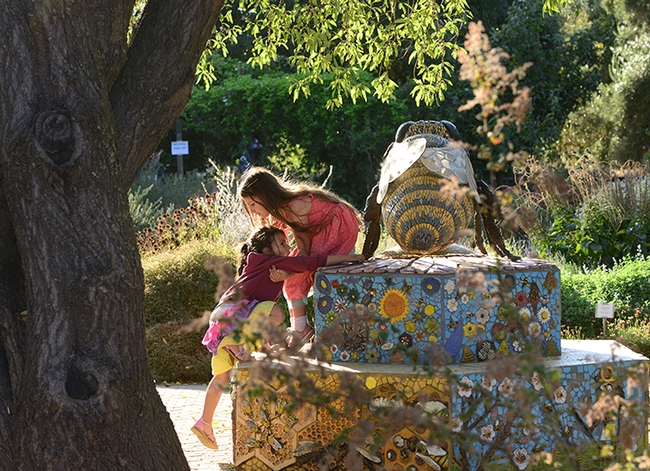
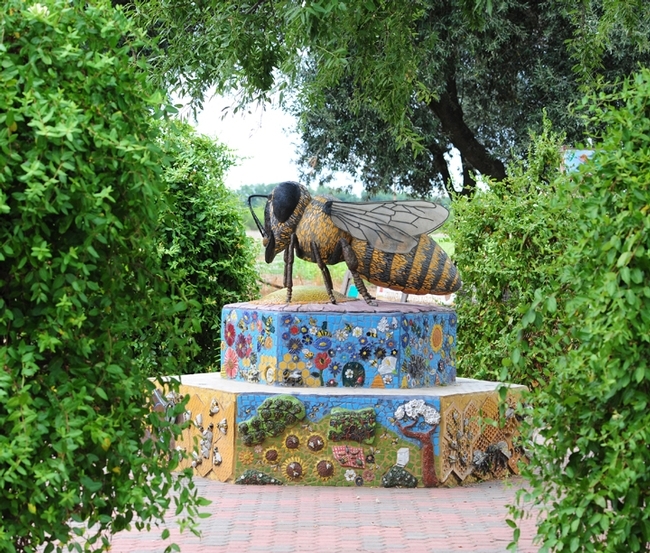
- Author: Kathy Keatley Garvey
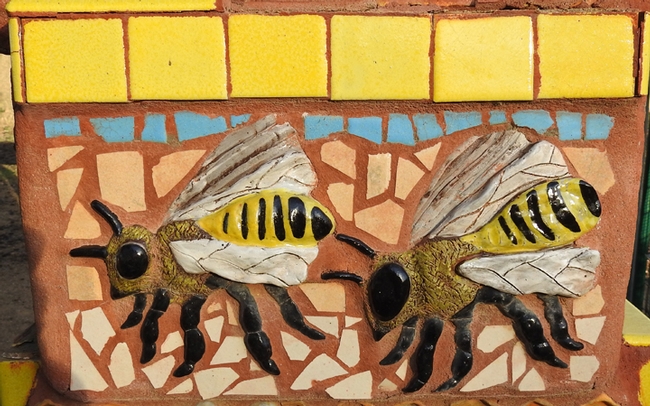
The UC Davis Department of Entomology and Nematology operates and maintains the half-acre bee garden, located on Bee Biology Road next to the Harry H. Laidlaw Jr. Honey Bee Research Facility, west of the central campus. It is open from dawn to dusk; admission is free.
The garden is directed by Extension apiculturist Elina Lastro Niño of the UC Davis Department of Entomology and Nematology faculty, and managed by Christine Casey, academic program management officer.
While parents learned about bees and plants, youngsters engaged in a catch-a-bee-release-the-bee activity in the vegetation, using a bee vacuum. They scooped up the foragers, looked at them, and released them.
"Hey, I caught the queen bee," said one boy, unaware that the queen was in her hive, busily laying eggs. During the busy season, a queen bee can lay about 1000 eggs a day, and during the peak season, about 2000 eggs a day.
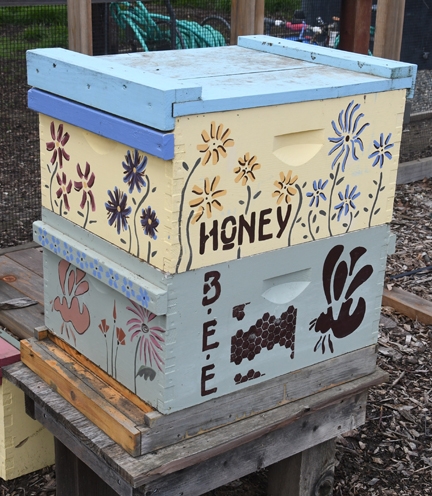
The garden, installed in the fall of 2009, was founded and "came to life" during the term of interim department chair, Professor Lynn Kimsey, director of the Bohart Museum of Entomology, who coordinated the entire project.
A Sausalito team--landscape architects Donald Sibbett and Ann F. Baker, interpretative planner Jessica Brainard and exhibit designer Chika Kurotaki--won the design competition.
The half-acre bee garden is anchored by Miss Bee Haven, a six-foot long mosaic ceramic bee sculpture that is the work of self-described "rock artist" Donna Billick of Davis. She and entomologist/artist Diane Ullman co-founded and co-directed the UC Davis Art/Science Fusion Program. The art in the garden is the work of their students, ranging from those in Entomology 1 class to community residents. Eagle Scout Derek Tully planned, organized and built a state-of-the-art fence around the garden.
The garden is named for the primary donor, the premium ice cream brand, Haagen-Dazs. Other major donors include the California State Society of the Daughters of the American Revolution (under the leadership of then State Regent Debra Jamison of Fresno). Names of many of the donors--those who gave $1000 or more--are inscribed beneath the Miss Bee Haven sculpture.
Missy Borel Gable, now director of the statewide UC California Master Gardeners' Program, served as the founding manager of the garden. Under her leadership and the work of the 19 founding volunteers, the bee garden was listed as one of the Sacramento Bee's top 10 garden destinations. The 19 volunteers chalked up 5,229 hours of service between May 2010 and Feb. 15, 2013, when they opted for other opportunities. At the $10 minimum wage, that would have amounted to $52,290.
Native bee specialist Robbin Thorp (1933-2019) distinguished emeritus professor of entomology at UC Davis, identified more than 80 bee species in the garden.
Today diversity continues. An addition to the garden since its installation is a live bee colony.
